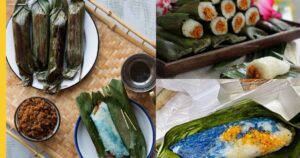In the vast tapestry of world cuisine, hidden culinary gems are waiting to be uncovered, each with its unique story and flavour. Among these treasures, Hinompuka, also known as Steamed Glutinous Rice Cake, stands out as a delicacy that bridges the gap between tradition and taste. In this article, we embark on a journey to explore the enchanting world of Hinompuka, its historical roots, and the cultural significance that has kept it alive through generations.
A Glimpse into the Origin
Hinompuka is more than just a dish; it embodies the Sabahan tradition. Originating from the Kadazan-Dusun community – the largest ethnic group in Sabah – Hinompuka is deeply embedded in the lives of its people. Whether during festive celebrations, community gatherings, or just a regular day, Hinompuka remains a staple, enjoyed by both locals and visitors alike.

The Basic Ingredients
Hinompuka is a type of rice cake, primarily made from glutinous rice flour, which gives the delicacy its distinct chewy texture. It is complemented by coconut milk, adding a creamy richness to the dish. Sweeteners like sugar or molasses are introduced to give it a delightful sweetness, while sometimes, small red beans or black-eyed peas are added for an extra layer of flavour and texture.
The Art of Preparation
The making of Hinompuka involves a process that speaks to its traditional roots. The glutinous rice flour is mixed with water to create a doughy consistency. The grated coconut and sugar are then incorporated into this mix, resulting in a thick paste. The paste is subsequently shaped into small balls, which are then wrapped in banana leaves. These leaf-wrapped delights are steamed until they achieve the desired consistency, producing a dish that’s not only tasty but also aesthetically pleasing with its verdant wrapping.

A Dish of Celebrations
Hinompuka isn’t just an everyday dish; it’s an emblem of festivities and cultural events in Sabah. Particularly during the Tadau Kaamatan or the Harvest Festival, Hinompuka plays a central role in the celebrations. The festival, which marks gratitude towards the rice gods for a bountiful harvest, sees Hinompuka being prepared and shared among families and friends, symbolizing unity and prosperity.
Modern-Day Evolution
While Hinompuka remains rooted in tradition, it hasn’t been immune to modern influences. Today, you might find variations that incorporate contemporary twists, from unique fillings to innovative presentation styles. These modern takes not only add diversity but also make the dish appealing to a broader audience, ensuring its continued relevance in today’s dynamic culinary scene.

Conclusion
Hinompuka is more than just a glutinous rice cake.; it’s a narrative of history, culture, and tradition, all packed into a delightful steamed ball. While the ingredients are simple, the emotions and memories it evokes are profound. For those venturing to Sabah, sampling Hinompuka is as essential as witnessing its mesmerizing sunsets or exploring its dense rainforests. And for Sabahans, it remains a cherished link to their roots and a testament to their rich culinary heritage.
Article curated by Himavee Jayaweera




